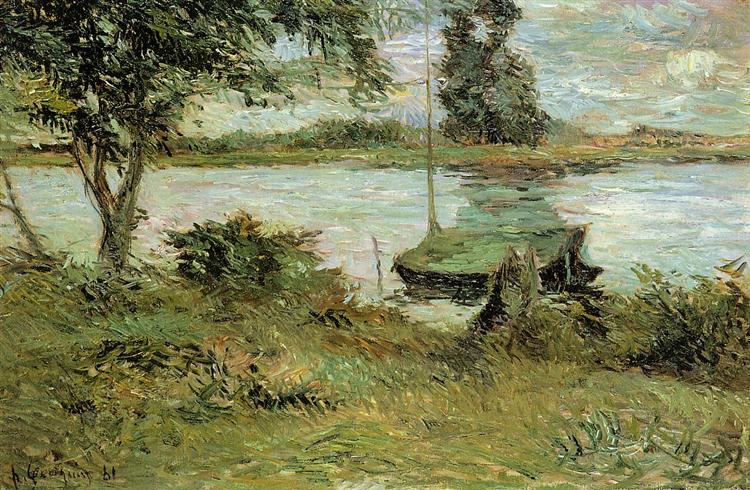Description
Paul Gauguin's painting "Banks of the Oise" (1881) is a work that encapsulates the beginnings of the artist's post-impressionist style, exemplifying his search for an emotive visual representation that transcends mere naturalistic observation. In this work, Gauguin paints a river landscape depicting the Oise River, a choice that already reveals his intention to link the everyday and the poetic. With an approach that goes beyond the surface, Gauguin uses nature as a medium to explore the complexities of human feeling through paint.
Looking at the composition, one notices a distinctive treatment of space and form. The structure of the painting is almost panoramic, with the river flowing in the foreground, its color reflected in the green and blue hues of the water. The trees that line the river become almost abstract elements, rigidifying the verticality and serving as a strong dividing line that enhances the sense of depth and distance. The way Gauguin applies color seems to correspond to a desire to capture the atmosphere of the scene rather than the literal truth of the light settling on the landscape.
The use of colour in “Banks of the Oise” is notable for its intensity and application of a vibrant palette. The hues, which range between yellows and greens, suggest a luminosity that invites the viewer to immerse themselves in the visual experience. This colouristic approach is a key feature in Gauguin’s work and a precursor to his later development towards greater simplification and symbolism in his work. Here, although the painting is representational, it also reflects his sensitivity to the rural life that surrounded him, capturing a moment that appears to be a celebration of nature at its most serene.
In terms of characters, "Banks of the Oise" lacks prominent human figures, which paradoxically invites a deeper reflection on the relationship of the human being with his environment. Without the presence of people, the viewer is immersed in the calm and splendor of the landscape, which could be interpreted as a commentary on the solitude or tranquility of the individual in the vastness of nature. This choice not to include human figures could indicate a zeal for the purity of natural experience or the exploration of a meditative state in the observation of the environment.
It is interesting to note that this work is set in a period when Gauguin was beginning to move away from Impressionism. Although his brush technique and love of bright colours still retain echoes of his contemporaries, his move towards a more personal expressiveness is beginning to be discerned in works such as this, paving the way for his boldest innovations in the 1890s.
The Banks of the Oise is thus a testament to Gauguin's evolution as an artist and a precursor to his future visions. In looking at this work, the viewer is not merely looking at a landscape, but is instead presented with an invitation to explore the intrinsic connection of human beings with nature, a theme that would continue to develop throughout the artist's career, eventually leading him to the Marquesas Islands and an even deeper understanding of his own quest. In this sense, the painting is not just a place, but a state of mind, a reminder of the simple beauty that life presents to us daily in its simplest and most authentic forms.
KUADROS ©, a famous painting on your wall.
Hand-made oil painting reproductions, with the quality of professional artists and the distinctive seal of KUADROS ©.
Painting reproduction service with satisfaction guarantee. If you are not completely satisfied with the replica of your painting, we will refund 100% of your money.

